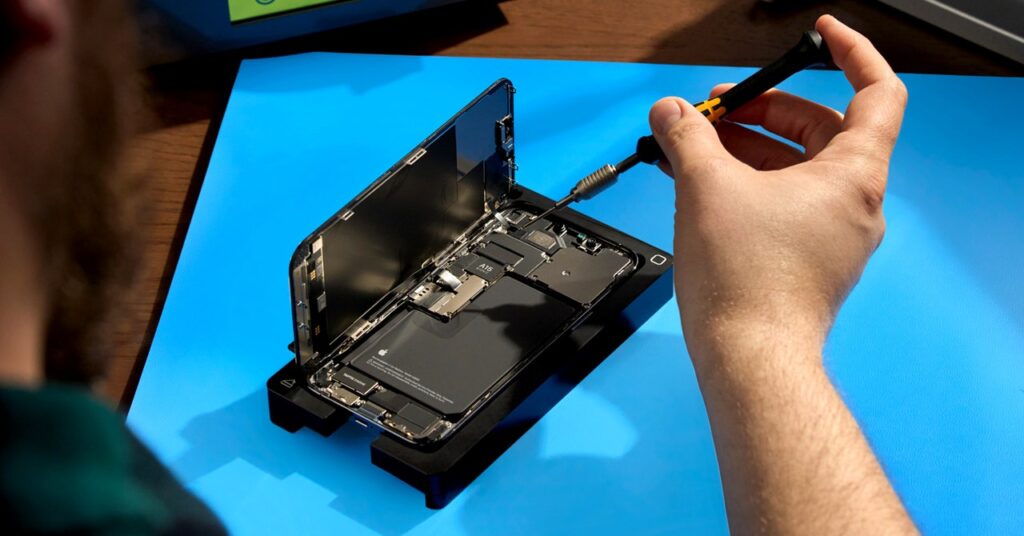Apple’s Self-Repair Program Is Off to a Bumpy Start
Plus, an early peek at the next version of Android, a pretty Ikea coffee-table book, and “earnings season” headaches….


For a very long time, Apple pooh-poohed the idea of letting you repair your own stuff. The company has even gone toe-to-toe with the US Congress to keep its tight grip on repairs of its tech. Then, last November, Apple announced it would give users the ability to access official repair manuals and “genuine Apple parts” to fix their devices. This week, the company launched that program, making self-repair kits available for newer iPhones. Thing is, Apple isn’t exactly giving people free rein.
Apple is keeping tight control over its parts. For a repair to be considered valid, users must use (and buy) parts stamped with Apple’s seal of approval. Having to buy serialized parts from Apple makes them more exclusive, and therefore more expensive, than third-party parts. Apple is also making the tools you’ll need to fix your device available to rent through its repair program. A one-week rental of a tool kit will cost you $49.
The right-to-repair advocate iFixit (which also sells its own phone parts and device repair kits) said Friday it was skeptical about the program, noting that the program is “not the unqualified win for repair enthusiasts” that Apple would have us believe it is. For now, Apple’s repair program offers parts for iPhones 12 and 13, and the third-generation iPhone SE. The company says it will make parts and services for Mac computers available later this year.
In the wake of a French law that requires manufacturers to display repairability ratings on their products, the right-to-repair movement has picked up steam. Companies like Samsung, Google, and John Deere (kind of) are working to get out ahead of legislation that will demand they make their devices more repairable.
Here’s some other news from the Gear desk.
Android 13 Cometh
The first beta for the next version of the Android operating system became available this week. Developers interested in testing a prerelease version of Android 13 are free to download and tinker with the new tech (provided they do it on a supported Pixel device). The mobile OS will be in beta for a few months, before being smoothed out into a final release that’s due to drop sometime this Fall. Google is bound to reveal more features of the software at its next I/O event, which is scheduled for May 11-12. We’ll have links to watch the keynote address on WIRED the day before the event.
Macs Made Money
It’s earnings report season, the joyful time of year when companies fess up to investors about how much money they’ve lost so far this year. Meta, the parent company of Facebook and Instagram, announced that while its user numbers had ticked upward slightly, its metaverse division lost the company $3 billion. In the same week that Elon Musk bought Twitter, the company admitted that it inflated its user numbers by a few million for the past couple of years and lost $128 million this quarter. Amazon hemorrhaged a net loss of $3.8 billion in the first quarter of the year, which it blamed on the pandemic and the Russian invasion of Ukraine. Apple sales, on the other hand, surged despite nagging supply chain issues, thanks to an ungodly high number of devices sold.
Ikea Wrote a Book
A new book uses the power of pretty pictures to spotlight people who live unconventional, sustainability-minded lives. Us & Our Planet ($30) is a collaboration between design and architecture publisher Phaidon Press and the relationship-ruining superstore chain Ikea. (No, you don’t have to assemble the pages of the book yourself.) The coffee-table tome is a showcase of resourceful living that aims to inspire people looking to contend with the effects of climate change. For those less interested in building bamboo structures or growing vertical gardens, the book also packs in plenty of gorgeous Ikea-heavy lifestyle photography. It’s also available in French, German, Spanish, and Italian.
Meet the Snap Gnat
ICYMI (as the kids say), Snap is a big deal. About 330 million users engage with the platform every day, even if it doesn’t get as much attention as smaller sites like Twitter. The company also has some hardware ambitions which border on the experimental. It previously tried out a pair of AR Spectacles. Now, Snap’s got a new selfie drone.
This week on WIRED’s Gadget Lab podcast, hosts Lauren Goode and Michael Calore talk all about Snap’s new flying camera, how the company fits into the social media landscape, and what’s up with all those pimple-popping videos.
Content
This content can also be viewed on the site it originates from.
More Great WIRED Stories




